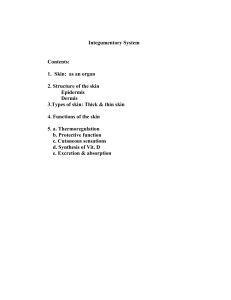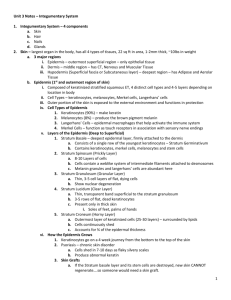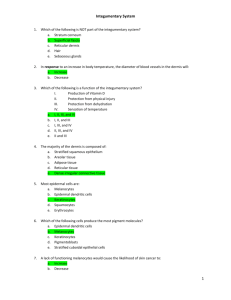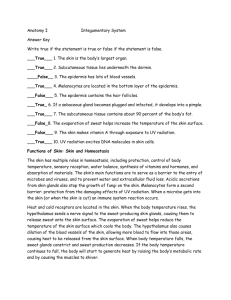IntegumentaryLab
advertisement
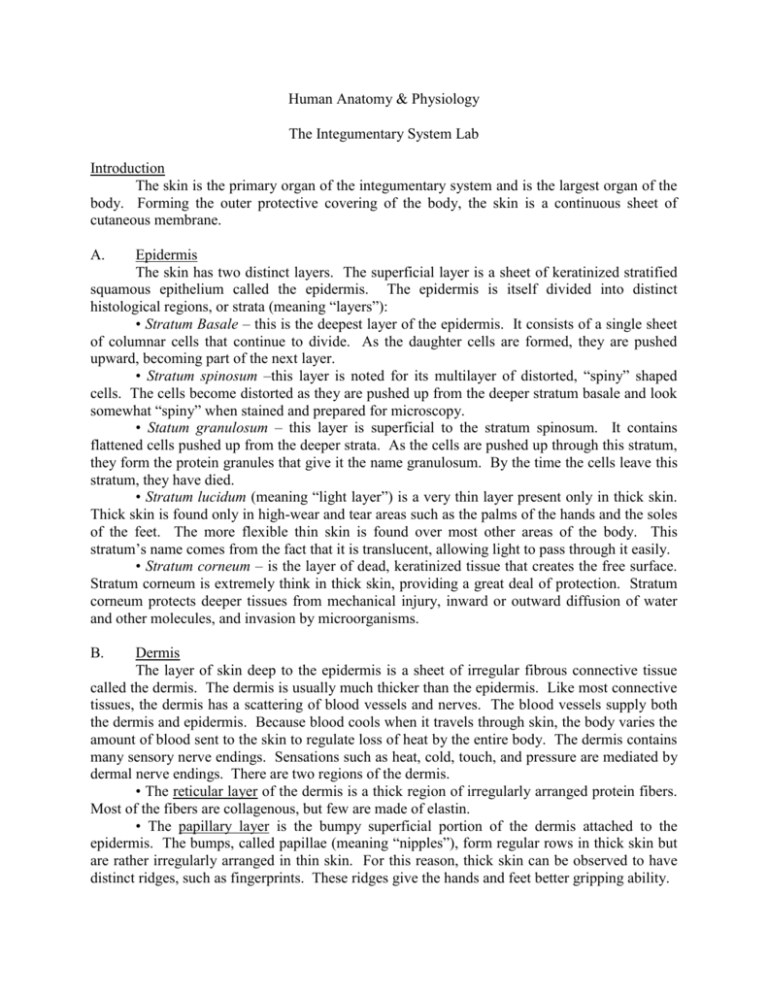
Human Anatomy & Physiology The Integumentary System Lab Introduction The skin is the primary organ of the integumentary system and is the largest organ of the body. Forming the outer protective covering of the body, the skin is a continuous sheet of cutaneous membrane. A. Epidermis The skin has two distinct layers. The superficial layer is a sheet of keratinized stratified squamous epithelium called the epidermis. The epidermis is itself divided into distinct histological regions, or strata (meaning “layers”): • Stratum Basale – this is the deepest layer of the epidermis. It consists of a single sheet of columnar cells that continue to divide. As the daughter cells are formed, they are pushed upward, becoming part of the next layer. • Stratum spinosum –this layer is noted for its multilayer of distorted, “spiny” shaped cells. The cells become distorted as they are pushed up from the deeper stratum basale and look somewhat “spiny” when stained and prepared for microscopy. • Statum granulosum – this layer is superficial to the stratum spinosum. It contains flattened cells pushed up from the deeper strata. As the cells are pushed up through this stratum, they form the protein granules that give it the name granulosum. By the time the cells leave this stratum, they have died. • Stratum lucidum (meaning “light layer”) is a very thin layer present only in thick skin. Thick skin is found only in high-wear and tear areas such as the palms of the hands and the soles of the feet. The more flexible thin skin is found over most other areas of the body. This stratum’s name comes from the fact that it is translucent, allowing light to pass through it easily. • Stratum corneum – is the layer of dead, keratinized tissue that creates the free surface. Stratum corneum is extremely think in thick skin, providing a great deal of protection. Stratum corneum protects deeper tissues from mechanical injury, inward or outward diffusion of water and other molecules, and invasion by microorganisms. B. Dermis The layer of skin deep to the epidermis is a sheet of irregular fibrous connective tissue called the dermis. The dermis is usually much thicker than the epidermis. Like most connective tissues, the dermis has a scattering of blood vessels and nerves. The blood vessels supply both the dermis and epidermis. Because blood cools when it travels through skin, the body varies the amount of blood sent to the skin to regulate loss of heat by the entire body. The dermis contains many sensory nerve endings. Sensations such as heat, cold, touch, and pressure are mediated by dermal nerve endings. There are two regions of the dermis. • The reticular layer of the dermis is a thick region of irregularly arranged protein fibers. Most of the fibers are collagenous, but few are made of elastin. • The papillary layer is the bumpy superficial portion of the dermis attached to the epidermis. The bumps, called papillae (meaning “nipples”), form regular rows in thick skin but are rather irregularly arranged in thin skin. For this reason, thick skin can be observed to have distinct ridges, such as fingerprints. These ridges give the hands and feet better gripping ability. B. Hypodermis Deep to the skin is a layer of subcutaneous tissue, sometimes called the hypodermis or superficial fascia. Although not a part of the skin, it is often studied along with skin. Subcutaneous tissue is loose, fibrous (aerolar) connective tissue that connects the skin to underlying muscles and bone. Some of the aerolar tissue has been modified to become adipose tissue. Adipose tissue’s protective and insulating characteristics complement the protection and temperature regulation roles of the skin. Procedure: 1. Observe the following slides and label the indicated structures: 1) Thin Skin a) Epidermis b) Dermis 2) Thick Skin (Squirrel Foot Pad) a) Stratum corneum b) Stratum lucidum c) Stratum granulosum d) Stratum spinosum e) Stratum basale f) Papillary Region of the Dermis g) Reticular Layer of the Dermis 3) Axillary Skin or Scalp a) Hair Follicle b) Sebaceous gland c) Arrector Pili Muscle d) Sweat Gland e) Sebaceous Gland f) Hair Follicle 1. Observe and draw three slides (but four drawings, since the hair follicle cross section will be 400x and 100x), making sure that you follow each of the following guidelines. • Include the magnification, give specific information off of the slide’s label, and label all relevant structures within the tissue. • If in doubt as to whether or not a structure should be labeled, follow this simple rule: if it is labeled in your textbook of the detailed cross-sectional handout, you must label it within your drawing to get full credit. • Each drawing will be on copier paper (within a perfect circle), cut out and attached within your lab notebook, then labeled after installation. • There will be no labels within the field of view, and all labels will connect with straight (ruler!) leader lines. 2. Use your textbook or another reference and the introduction to this lab to research each skin type as you draw it. Write down useful summaries (structure, function, and/or location of the skin type and/or specific structures) next to each picture. 3. Be sure to quiz your group members!! Post Lab Analysis: 1. What are the five functions of the integumentary system? In addition, please be specific as to how each one is accomplished. 2. (Double Points) Explain pigmentation in skin: all colors possible (including albinism, jaundice, and cyanosis), how each is created, how melanocytes/melanosomes work, and variance in color intensity among different areas of the body and among different peoples. 3. Differentiate among the various glands of the integumentary system. Please address location, function, products, etc. 4. Summarize the creation, maturation, and different forms that hair can assume.



